Mystic India -may it always remain so!
- Tamanna Mohapatra

- Feb 24, 2015
- 5 min read
I am from India and within India, from a state called Orissa. Although Orissa is famous for its thousand and one temples, (it’s known in India as the temple state) for some reason I prefer visiting temples outside my state. I suppose it’s a ‘grass is greener on the other side of the fence’ case.
In any event, this year I was lucky enough to visit two architecturally wonderful places in central India as well as an equally beautiful temple right in the backyard of my home city (home as much as that’s where I grew up.)
I was so enamored and touched by the beauty of the temples and architecture I saw that I vowed to share the knowledge gained and feelings experienced during the trip on this blog, so here we are.
I begin this virtual journey at Khajuraho. I left that place believing I must have some past life connection with it to have it feel so special and emotional. A few facts about the place; some better known than others:
The famous Khajuraho temples were built in the period 950 to 1000 AD (that’s about a 1000 years ago) and rediscovered in the 1800’s by the Britishers during their time in India.
Khajuraho is derived from the word ‘khajur’ which is the sanksrit word for the date fruit. The belief being that in the olden days there were many date palm forests located in that area.
In the year 1986, UNESCO recognized Khajuraho as a World Heritage Site for its “human creativity”, and it became one of the 32 world heritage sites discovered and honored in India.
It is considered by some as the second most visited place in India (after the Taj Mahal).
Of the supposedly 85 temples constructed during that era, only about 20 remain; they fall into three distinct groups and belong to two different religions – Hinduism and Jainism.
The temples are known primarily for two things- the style of temple architecture and the explicit and enthralling friezes (the long narrow band of sculpture that runs alongside the outside walls of a temple) adorned with many scenes of daily life including war, worship, and an adequate showering of detailed and uninhibited erotic imagery.
These sculptures, besides being an architectural wonder are often misunderstood by many (natives and tourists alike) as something to snicker over or be embarrassed about. I was lucky enough to get a guide who explained the beauty and spiritualness of the place as well as the sculptures. It made me look at them with a different perspective and almost had me jealous of the past life depicted and sad for all of us living in today’s world were we have come to debase something so essential to and beautiful in life.
In fact, I read this beautiful quote from one of the guide books which summarizes the beauty of the sculptures very aptly, ” The sculptor’s fine skill and a sense of imagination have here given form to human emotion by depicting through stone both spiritual and physical love.”
Khajuraho temples are also the site of a very famous cultural event known as the ‘Khajuraho dance festival. I believe it’s an international event with classical dancers from all over the world participating in this annual 3-4 day event. It was so successful that it inspired similar festivals in other parts of the country that associate classical indian dances with temple sites. Here’s a listing of the more famous ones. They are each worth checking out if one is interested in classical arts of India.
The temples are located in reality a very small village- scenic, low key, and very aware of its reasons for being on all maps- national and international. It’s amusing that this village which doesn’t even boast of its own high school or college, has no nightlife in its tiny downtown (despite throngs of international tourists); still has an airport connecting it with daily flights to the capital of the country and hotels from almost all the major chains including Ramada, Taj, Radisson etc.
A deeper look into the sculptures and the architecture:
While researching this blog piece, I learnt a lot of interesting facts and fables about this most unique place and also in general about temples and temple architecture.
For example, some of the larger temples in the Khajuraho group of temples are known as ‘Panchayatan’. That is a sanskrit word which refers to the number five. In this case, each of the larger temples is a five shrine temple; a shrine being each of the temple buildings which housed a deity in the past. So a Panchayatan temple is one that comprises of a large central shrine housing a deity to whom the temple is dedicated and four subsidiary shrines at the four corners of the platform dedicated to other related but not primary deities.
Most of these temples (except for one Shiva temple in the outskirts of the main periphery known as the Matangeswar temple) are now considered historical buildings with no worship happening within. That’s why from a religious perspective, they can accept visitors from all over the world who may or may not be worshippers.
The main temples are the Kandariya temple (largest and most ornate of the group dedicated to Lord Shiva of the Hindu trilogy of Gods), the Lakshmana Temple (dedicated to Lord Vishnu, another God from our trilogy). the Vishwanath and Parshwanath temples; the last one being actually a Jain temple (a religion with more similarities with Buddhism than Hinduism). In my eyes, this makes the temples even more special because in their own way they are a symbol of religious secularism. For those further interested, this table from wikipedia has done a marvelous job of describing-both in words and pictures- each of the main remaining temple sites.
It seems the stones used in the Khajuraho temples were very receptive to chiseling and allowed the sculptors to carve minute details like folds of garments, ornaments, drops of water (there is a statue of a lady wringing water from her hair), nails and creases of the skin as well. Each slab of stone was chosen, sanctified and carved before it was placed in its allotted space. Any stone that got damaged would be discarded as it was considered inauspicious.
Believe it or not, there is actually a theme to the sculptures. In fact there are five groups of carvings. The first category comprises of formal cult images of principle deities such as Shiva, Vishnu, Jain leaders. Then come the divinities: minor Gods and Goddesses, including celestial nymphs. This group includes all the sculptures of women in various forms and moods. According to the author of the guide book, it’s very possible that for the artists creating these statues women symbolized the creative energy and thus they went ahead and depicted women in various forms (as a river, as a Goddess, as a dancer) and participating in various activities (dressing up, writing a letter, being amorous) etc. The third category of sculptures are known as the mithunas and depict couples in various physical acts/positions. The fourth category depicts groups of dancers and musicians, hunting scenes, marching armies and such. And finally, the fifth group comprises solely animal sculptures-both real and mythical.
They say the grace and liveliness in the figures which is truly palpable is the outcome of a technique known as ‘Anga Nyasa’- again a sanskrit/ancient word which explains that the weight of the stone body is divided to give a bend to the sculptures whether the poses are front, back, or sideways.
In conclusion I would sum up my experience as truly unique and mesmerizing and my recommendation as a ‘must visit’ destination. Next, I will try share my experiences on the architectural wonders of the fort city of Gwalior.
Reference and quoted from: Khajuraho local guidebook by Dr. Rajaram Panda
References:
http://www.devalt.org/newsletter/apr99/lead.htm
http://whc.unesco.org/en/list/240








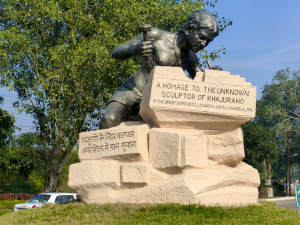









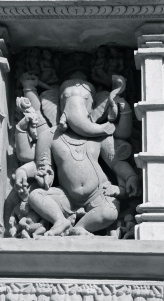

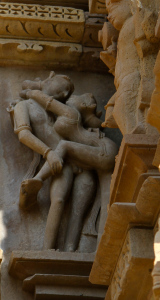

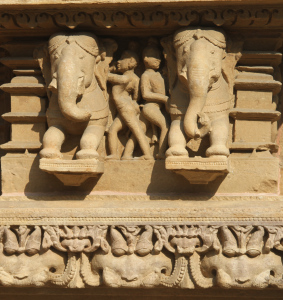



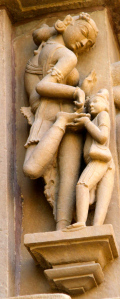



Ena mausi this is one of your masterpieces, I must say. What a wonderful piece of writing! I was enthralled till the last word! You should be a historian!!! Now I have got really interested in visiting these temples!!!